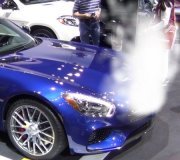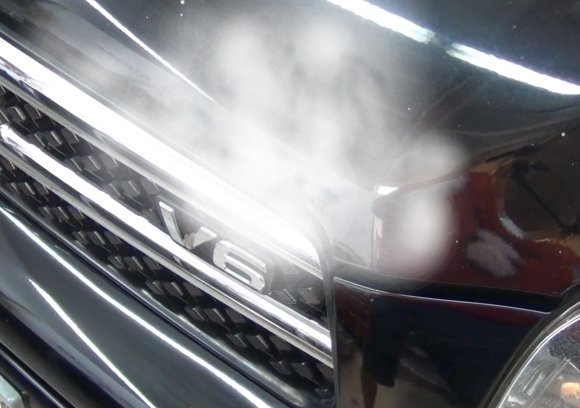Oooh. That made the hair on my neck stand up. A new fellow who worked next to me at a very nice family-owned Chrysler dealership had been warned numerous times about wasting way too much time. In his case he was working on trade-in cars, but money changed hands on paper. The Used-Car Department transferred dollars to the Service Department for the safety inspections, oil changes, and repairs, then, the additional costs they had in that car resulted in lower profits when it was sold, and therefore, lower commissions for the salespeople.
The car in question had only cold air from the heater and the temperature gauge stayed on "Cold". Understand we always diagnose the cause of a problem, THEN order and pay for parts that often can't be returned. Do-it-yourselfers skip the diagnostics part and often just throw multiple random parts at a problem until one fixes it. That is the least effective and most expensive way to solve a problem. However, given the two matching symptoms, and that this is such an extremely common problem, the mechanic should have simply replaced the thermostat and moved on. Since this will solve the "cold air" problem on 99 out of 100 cars, no one would fault him if this turned out to be the wrong solution. Instead, he fiddled with all kinds of "tests" we had never seen or heard of. The people in the Parts Department got wind of the major lack of efficiency and ordered a thermostat locally for that car. After lunch break, the mechanic finally went to the Parts Department to order the thermostat, and lo and behold, it was already there.
He installed the new thermostat, warmed up the engine, and would you believe it, the air from the heater was hot and the temperature gauge read "normal". You would think that would be the end of that job, right?
Nope, after being repeatedly and strongly warned by many of his coworkers, he punched two holes in the top of a soup can, fished a piece of wire through them so it could hang from a vise handle. He filled it with water and a thermometer, dropped the thermostat in it, then sat there for a half hour heating it with the torch. That was his last day working there. How could the Service Department justify billing the Used-Car Department over $600.00 to replace a thermostat?
This type of experiment could make a dandy demonstration in school where we are learning theory of operation, but I never did this for my students, or even talked about it, because I did not want to risk anyone ever trying that on the job. A running engine burns fuel and gets real hot. What else is there besides a thermostat stuck open that will prevent the engine from reaching normal operating temperature?
An additional problem with this "test" is a good thermostat will only start to open near 195 degrees. It can take as much as 215 degrees before it is opened fully. At which temperature do you consider it to be "open"? Also, you might not see it start to peek open at 175 or 180 degrees. That can be enough to allow coolant to circulate to the radiator before it is hot enough. Air from the heater will be equally not hot enough. The thermostat has opened too soon, but not enough to see, so what did the test prove? And what if the thermostat does stay closed until at least 195 degrees? Are you going to stick it back in the engine and risk having the same problem, especially when it is such a common problem?
As for the rust color in the reservoir, GM is famous for using red Dex-Cool antifreeze. We call that "Dex-Mud" because that's what it turns into. All antifreeze is an alcohol that will always be alcohol. We need to replace it every two years because it is the critical additives that wear out. Those include water pump lubricant, corrosion inhibitors, and seal conditioners. In an effort to falsely make their cost of general maintenance appear to be lower than that of their competitors, GM advertised this coolant as "lifetime" coolant. Then, on the side of the reservoir, they planted a sticker that no one looked at that said to replace it every three years. That was their "out" for legal purposes. Even the Dex-Cool company specifies the coolant be replaced every two years.
As a result of believing the false advertising of lifetime coolant, GM owners are way too familiar with corroded and leaking heater cores and radiators. The acids that naturally build up in the coolant over time also attack cylinder head gaskets. We have enough trouble with that on all car brands already without inviting more problems by leaving old coolant in there. This is just one more of many of GM's lack of foresight. Who cares about repair cost after you buy the product, and the resulting bad reputation, as long as you buy the product. There is always more new, unsuspecting customers next year. To make matters worse, if your mechanic has your best interest at heart, he will recommend a cooling system drain and refill, or a flush, every two years to prevent these problems. In return he will be accused of trying to sell parts and services that aren't needed. Those false claims of "lifetime" coolant will be used as proof he is trying to defraud you.
The rust-colored stuff in the reservoir is often not an indicator of a serious condition. It can be caused by engine oil seeping through the head gasket over time, and it can come from rubber heater and radiator hoses starting to deteriorate. More commonly it is from an accumulation of worn-out additives that flow into the reservoir, then accumulates there when it is cold. We normally wash that out when we do a system flush.
Tuesday, January 3rd, 2017 AT 3:47 PM


